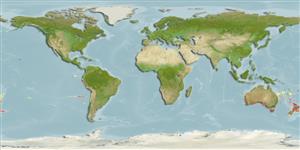>
Perciformes/Scorpaenoidei (Scorpionfishes) >
Triglidae (Searobins) > Pterygotriglinae
Etymology: Pterygotrigla: Greek, pterigion, diminutive of pteryx = wing, fin + Greek, trigla, es = red mullet (Ref. 45335).
More on author: Günther.
Environment: milieu / climate zone / depth range / distribution range
Écologie
marin bathydémersal; profondeur 160 - 500 m (Ref. 9771). Deep-water
South Pacific: off the coast of Chile near Isla Juan Fernandez, Isla San Felix, and neighboring guyots of the Sala y Gomez and Nazca Ridges (160-350 m), reported from Easter Island and westward to the Norfolk Ridge, New Caledonia; and other seamounts and ridges.
Taille / Poids / Âge
Maturity: Lm ? range ? - ? cm
Max length : 38.0 cm SL mâle / non sexé; (Ref. 89467)
Description synthétique
Clés d'identification | Morphologie | Morphométrie
Mostly red in color with prominent black spots.
Occurs on the continental shelf and slope (Ref.9563). The depth range is indicated 60-320 m in Ref. 89357.
Life cycle and mating behavior
Maturité | Reproduction | Frai | Œufs | Fécondité | Larves
May, J.L. and J.G.H. Maxwell, 1986. Trawl fish from temperate waters of Australia. CSIRO Division of Fisheries Research, Tasmania. 492 p. (Ref. 9563)
Statut dans la liste rouge de l'IUCN (Ref. 130435: Version 2024-1)
Menace pour l'homme
Harmless
Utilisations par l'homme
Pêcheries: pêcheries vivrières
Outils
Articles particuliers
Télécharger en XML
Sources Internet
Estimates based on models
Preferred temperature (Ref.
123201): 11.8 - 15, mean 12.9 °C (based on 28 cells).
Phylogenetic diversity index (Ref.
82804): PD
50 = 0.5000 [Uniqueness, from 0.5 = low to 2.0 = high].
Bayesian length-weight: a=0.01259 (0.00513 - 0.03091), b=3.01 (2.80 - 3.22), in cm total length, based on LWR estimates for this (Sub)family-body shape (Ref.
93245).
Niveau trophique (Ref.
69278): 4.5 ±0.80 se; based on food items.
Résilience (Ref.
120179): Milieu, temps minimum de doublement de population : 1,4 à 4,4 années (Assuming tm=3-4).
Fishing Vulnerability (Ref.
59153): Moderate vulnerability (36 of 100).
Climate Vulnerability (Ref.
125649): High to very high vulnerability (71 of 100).
Nutrients (Ref.
124155): Calcium = 30 [16, 73] mg/100g; Iron = 0.501 [0.253, 1.042] mg/100g; Protein = 17.2 [15.4, 18.9] %; Omega3 = 0.609 [0.261, 1.764] g/100g; Selenium = 15.3 [6.5, 37.7] μg/100g; VitaminA = 23.5 [5.2, 111.5] μg/100g; Zinc = 0.351 [0.237, 0.535] mg/100g (wet weight);
